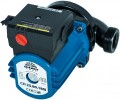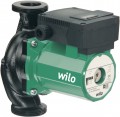Minimum fluid temperature
The lowest fluid temperature at which the pump is capable of operating normally.
Almost all pumps can normally transfer cool water, regardless of the purpose (see above); therefore, for normal household use, this parameter is not critical and for some models, it may not be indicated at all. But if you need the ability to work with liquids with temperatures below 15 °C, you should pay close attention to the minimum temperature. Some models that can be used with antifreeze normally tolerate even temperatures below zero.
Max. fluid temperature
The highest liquid temperature that the pump is capable of operating normally.
The possibility of using the unit directly depends on this parameter (see "Suitable for"): for example, models for heating systems must tolerate a temperature of at least 95 °C, and for DHW supply — at least 65 °C. Well, anyway, this parameter should not be exceeded: an overheated pump will fail very quickly, and the consequences of this can be very unpleasant.
Max. power consumption
The electrical power consumed by the pump during normal operation and maximum performance.
This indicator directly depends on performance — after all, for pumping large volumes of water, an appropriate amount of energy is needed. And the power depends on two main parameters — electricity consumption and the load on the power grid, which determines the connection rules. For example, pumps with a power of more than 5 kW cannot be connected to ordinary household sockets; more detailed rules can be found in special sources.
Shaft material
It is the material from which the motor shaft in the pump is made.
— Cermet. It is a material that combines metals and their alloys with non-metallic components. In modern pumps, different types of cermets can be used, differing in price and quality; usually, the features in each case directly depend on the price category of the unit. However, it is well suited for household models with relatively low performance but is poorly suitable for professional use. Therefore, in pumps of more than 15,000 litres per hour, cermet shafts are rarely used.
— Stainless steel. This material is highly durable and reliable, due to which it is found in almost all categories of pumps — from relatively simple to professional, the performance of which is in the tens of thousands of litres per hour. However, it is somewhat more expensive than cermets.
Country of brand origin
In this case, the country of origin refers to the country from which the product brand originates. A brand, in turn, is a general designation by which the products of a particular company are known in the market. The country of its origin does not always coincide with the actual place of production of the product: to reduce the cost of production, many modern companies transfer it to other countries. It is quite normal for products, for example, of an American or German brand, to be made in Taiwan or Turkey. Contrary to popular belief, this in itself does not lead to a decrease in the quality of the goods — it all depends on how carefully the brand owner controls the production. And many companies, especially large and famous ones, monitor the quality very zealously — after all, their reputation depends on it.
Protection class
It is an indicator that determines the degree of protection of dangerous (moving and current-carrying) parts of the hardware of the pump from adverse effects, namely solid objects and water. Since pumps, by definition, are used for pumping liquids, and many of them can normally pass quite large particles, in this case, we are talking about protection against moisture and objects from outside.
The level of protection is usually indicated by a marking of the letters IP ("ingress protection") and two numbers, the first of which indicates protection against the effects of solid objects, and the second — against the ingress of water.
For the first digit, each value corresponds to the following protection values: 1 — protection against objects with a diameter of more than 50 mm (large body surfaces) 2 — against objects with a diameter of more than 12.5 mm (fingers, etc.) 3 — against objects more than 2.5 mm (most tools) 4 — against objects larger than 1 mm (virtually all tools, most wires) 5 — dust-proof (total protection against contact; the dust can enter, but does not affect the operation of the device) 6 — dust-proof (case with full dust protection and contact).
For the second digit: 1 — protection against vertically falling drops of water 2 — against drops of water with a deviation of up to 15 ° from the vertical axis of the device 3 — against drops of water with a deviation of up to 60 ° from the vertical axis of the device (rain) 4 — again...st splashes from any direction 5 — from jets from any direction 6 — from sea waves or strong water jets 7 — short-term immersion to a depth of up to 1 m (without the possibility of continuous operation in immersed mode) 8 — long-term immersion to a depth of more than 1 m (with the possibility of permanent operation) in immersed mode).
In some cases, one of the numbers may be replaced by the letter X — this means that the official certification for the corresponding parameter has not been carried out. In pumps, X is usually put in place of the first digit, because a high degree of moisture resistance in itself means a high degree of protection against solid contaminants. At the same time, for such models, an additional letter index can be provided, which describes the degree of protection against specific solid objects — for example, IPX2D. The letter D corresponds to the highest degree of stability, which does not allow the wire to be hit; the previous options A, B and C respectively mean protection from the hand, from the finger and a small tool like a screwdriver.

